Grapes "Black Pearl": features of the variety, agricultural technology and application
Grape gazebos are not only a beautiful decoration of a secluded corner of the garden, but also tasty, and most importantly useful, large hanging bunches of berries. Grape almost all people love. A wide variety of species are grown. Someone chooses dark varieties, others - light ones. One of these dark varieties, a bright jewel of gardeners, is the Black Pearl grape.
Content:
- Description and benefits of the variety
- Application
- Landing: timing and rules
- Care: watering, feeding and pruning
- Diseases and pests
Description and benefits of the variety
The Black Pearl grape variety is a fairly young species. He was brought to the Y. Potapenko Research Institute just 12 years ago (in 2005).
Features of the variety:
- The fruits are a hybrid of such eminent representatives of the family as the Magarach Centaur crossed with the Levokum variety and August combined with the Amur grapes. The result is a highly valuable wine-technical look.
- Its leaves are distinguished by their medium size, rugged appearance and pentagonal shape. From above, each leaf is covered with a bubble wrap. The lower part of the leaf is covered with soft, short felt fibers. The difference in the variety is observed in the crossing of the blades of the petiole fossa. It is also noted that the petiole practically does not differ in length from the central vein. The edges of the plate are bent towards the top, and the side cuts have different heights. Leafy young, elongated vines differ in the bare edge.
- The berries are collected in cylindro-conical bunches, in which one or two wings stand out. The fruits in the brush are not tightly pressed, but they hold tightly to each other. Each bunch weighs about 300 grams. In appearance, they are not large, larger to medium size. Ripening is due to the first half of September. Pearl beads have a somewhat elongated shape; as they ripen, they acquire a dark blue tone. When ripe, the inside of the berries is light in color, with a fleshy structure. The fruits have a nutmeg flavor, and when crushed, the juice does not stain, remaining slightly yellowish in color.
- The shrub has strong growth. In order for the plant to give good yields, the growth of young vines should be controlled. It is not recommended to leave more than 18 eyes on one bush. Otherwise, it is possible to either drive the variety, or the crop will be small and of poor quality.
The variety is noted for a sugar content of 23-24 g per 100 cm3, while the acid remains at 6-7 g / dm3. Breeders distinguish the yield of the variety as high. Under favorable conditions and high-quality care, the plant is capable of producing 130 centners per hectare of planted area.
The benefits of Black Pearls are as follows:
- Possesses sufficient frost resistance. It does not freeze at a temperature of -260C, but it needs to be covered for the winter.
- Cuttings of a young vine, with proper rooting in the fall, quickly take root and are able to please with the first berries in 2 years.
- When ripe, the bunches exude a pleasant enticing aroma.
- The rapid growth of the vine allows you to quickly compensate for the damage caused by frosts.
The only drawback of the precious shrub is its great susceptibility to pests and diseases. In addition, the plant has great requirements for the planting site.
Application
The grapes are grown for use as raw materials. It is used to make wine. The wine product is obtained with high quality characteristics, characterized by a pleasant aroma and nutmeg aftertaste notes. Some winemakers add an additional 20% to the total volume of Augusta grapes for the richness of the nutmeg bouquet and strawberry-pink aftertaste.
Young table wine, aged for one year, is estimated by experts at 7.6 units on a tasting scale of 10 points. For a dessert drink, aged under special conditions for several years, experts give a solid 9 for its taste, aroma and lack of astringency.
Berries are also used for culinary dishes and in conservation.
The fruits can be frozen or eaten fresh. He is especially popular with young children. Also, raisins with distinctive taste characteristics are made from berries.
The most interesting thing is that whatever manipulations are performed with the fruits, they do not lose their beneficial properties and the microelements and vitamins contained within.
Landing: timing and rules
Grape - a shrub that lives for a long period of time. It can please with large volumes of harvest for 20-22 years. The main thing is to plant the seedling correctly. The best option for planting shrubs is the southwestern, southern or eastern side. It is here that there is more sunshine and the piercing drafts and winds are not so strong.
Immediately after planting, it is recommended to put the vine on the trellis or to put up a support. Roof slopes or a building wall work well. It is good if the bush is placed on a small slope, but not at the base, but at the top or in the middle, where water will not stagnate. High humidity is destructive for this variety. The soil for planting is prepared in advance. It is fertilized compost, nitrogen and organic additives... For rapid growth and development, a fertile, rested land is needed. Landing is carried out in the spring or autumn.
Choose healthy seedlings. Such an instance must meet the requirements:
- white root on the cut
- bright green color of young leaves
- strong eyes that do not fall off when touched
In order for the seedling to better tolerate rooting, it is prepared - the lower roots are slightly cropped, and the upper ones are completely cut off. And the young vine is shortened by 3-5 eyes, so that until the roots take root, the plant spends less stored nutrients on the maintenance of a long shoot. After that, the planting material is kept in water for 24 hours.
If the garden soil is saturated with black earth or clay, then the recommended hole depth is 80 cm.
The same size should be the width. Otherwise, if sandy soil predominates, a hole should be dug up to 1 meter. Such a deep hole is necessary to protect the roots from winter drops in temperature. At the bottom of the dug recess, a 15 cm layer of drainage is laid out in the form of expanded clay or crushed stone. A pipe for internal irrigation is installed on the edge. The diameter of the device should not exceed 1-1.5 cm.

A layer of phosphorus and potash fertilizer mixed with black soil is placed on top of the drainage. You can also add a small amount wood ash, as a mineral fertilizer. A similar pattern is repeated 2 times so that the depression is completely filled with fertile soil. The last step is abundant watering.
When the time comes for planting the finished seedling in the ground, it must be kept in a consistency:
- Humate -1 spoon.
- Clays - to the state of sour cream.
- 10 liters of water.
The seedling is planted in an upright position so that the buds are facing north, and the radicular heel is facing the south side. The roots must be carefully released from the ground and straightened.A stalk is placed in the dug recess. Root system deepens by 15 cm, and everything that remains higher up to the aboveground part is compacted with a mixture of black soil and sand. The earth is well tamped so that no hollow depressions remain.
Mulch on top and cover with a film. A bank is put on the seedling so that the sprout is completely rooted in a new place. Watering is carried out through a supplied pipe inside the soil.
The preparation of the soil substrate is carried out in early autumn. There are two options for planting a grape bush:
- In the fall, after 1.5 months have passed after the preparation of the pit. Mid-October is best. After planting, the bole should be densely covered with soil and covered high with fallen leaves or needles. The top is additionally covered with a layer of sawdust or peat.
- In spring - planting is possible after the end of the last frost. An excellent time is late March - early April.
Thus, if you carry out the rooting and planting of the cuttings according to simple rules, you can get a new fruiting shrub of a valuable grape variety in a short time.
Care: watering, feeding and pruning
In order for the plant to grow quickly and give good yields, you should pay attention to high-quality watering and periodic top dressing... The first step in the spring is to carry out the process of loosening, compacted soil when planting. Clear the stamp from bushes. As young leaves appear, the hole around the trunk should be deepened. This process is necessary for the bush to be hardened.
By July, 3-4 good-length branches already appear on the shrub. Of these, you need to leave one of the strongest and most powerful. The shrub will direct all the nutrients to it, and by the end of autumn you can get a well-developed woody vine.
Watering is carried out once a week, but in the amount of 10 liters per cutting.
At the same time, feeding is also possible. The fertilizers include: ammonium nitrate, superphosphate, ammonium sulfate.
Necessarily required to conduct pruning (if you do not carry out the procedure, then the shrub will overgrow with a vine and will not yield a crop):
- The first procedure consists in breaking the buds - they must be removed if they do not have fruit branches. In addition, excess vines growing from one eye and all weak, underdeveloped and lagging shoots are subject to pruning.
- The second stage is pinching. It is realized in late June - early July, when clusters begin to form. The top growth point is removed. The procedure is needed so that the grapes send all the nutritional properties to the grapes that are pouring.
- The last stage of pruning is done 2-3 weeks before harvest. All old leaves located in the lower part of the shrub are cut off, as well as those greens that interfere with the receipt of sunlight for ripening brushes.
Thus, in order to get a bountiful harvest, it is required not only to water and feed on time, but also to produce high-quality pruning.
Diseases and pests
The most dangerous pest for Black Pearls is the spider mite. It feeds on juice from leaves and cuttings, while emitting a poisonous consistency. The latter, in turn, infects the leaves. Greens curl, turn yellow and fall off. The reason for the appearance is the increased air temperature and the abundance of weeds around the trunk.
To neutralize a harmful insect, it is advisable to introduce a number of measures:
- Settlement of the bush by the enemies of the tick - flower bugs and ladybirds.
- Removal of weeds and other grasses around the vine.
- Irrigation of cuttings and leaves with insecticides designed to fight parasites.
- The affected areas of bark or leaves must be removed and burned.
Aphids and root phylloxera are no less harmful parasites. To eliminate it, it is recommended to act with systemic insecticides. With an invasion of leaf rollers, if they are untimely detected, up to 85% of the total crop can be destroyed. When neutralizing insects, use:
- in the spring herbicides
- in the summer months for butterflies - insecticides, while spraying every 2 weeks
- when caterpillars - insecticidal preparations
Black pearls are very susceptible to disease. He can be struck by such types of diseases as anthracnose and powdery mildew, bacteriosis or bacterial cancer.
Thus, in order to avoid any type of disease, the condition of the plant should be monitored, watered with the optimal amount of water so that moisture does not stagnate, and also properly care for the precious variety.
More information can be found in the video:



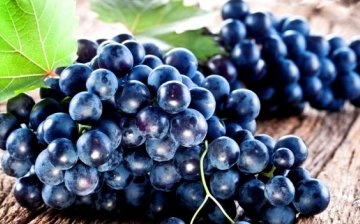
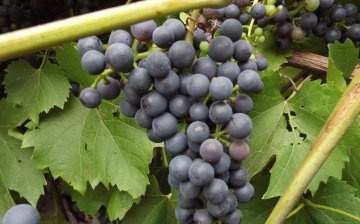

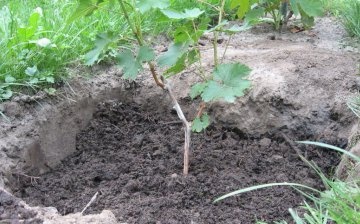
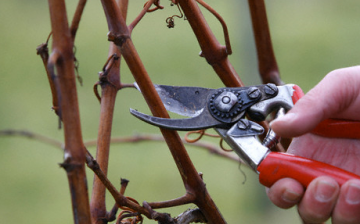
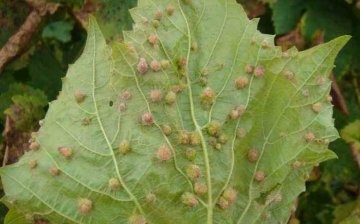






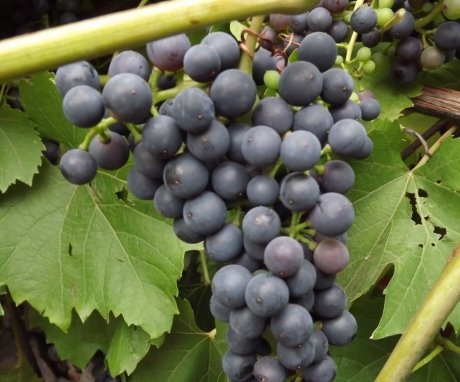

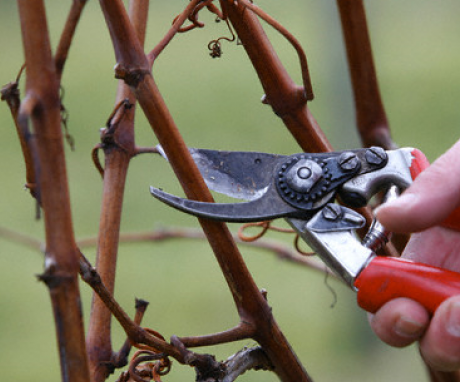
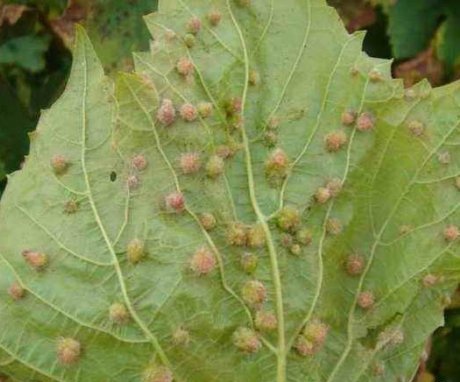
I really like to make compotes from home grapes for the winter and, of course, delicious and aromatic wine. The process itself is, of course, painstaking and requires some experience and time, but the result is worth it.
With such a high palatability, as well as a high percentage of sugar in ripe berries, grapes are best used as raw materials for making wine. If you keep it for several years in oak barrels, you get an excellent red vintage wine.